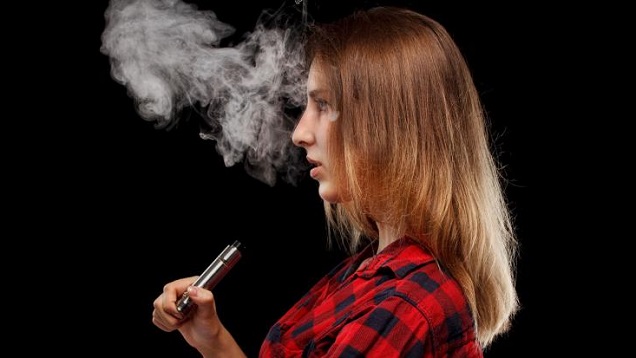
“Your child could be ‘dripping’ – and it's extremely dangerous,” according to the intrepid reporters over at NBC2.
The Sun dove right into the deep end with their headline: “VAPE ABUSE New e-cigarette ‘dripping’ craze that gives teens stronger hit ‘increases risk of exposure to harmful toxins’”
“Vape abuse,” seriously?
So what the hell has happened?
The short version is that researchers discovered the existence of dripping and have released a study looking at how common it is in teens. It turns out that about a quarter of teens who’ve ever vaped have tried dripping at least once.
Of course, if you know what dripping is, this isn’t particularly alarming or even especially interesting. Vapers have been dripping for years. Sorry, I meant to say we’ve been “abusing” vapes for years with our “new, dangerous trend.”
When the media got wind of this, we were destined to enjoy a flurry of re-written press releases masquerading as journalism and plastered with alarmist headlines, but they’ve really pushed the boat out here. Despite the fact that dripping is ultimately just ordinary vaping without a tank, they’ve somehow managed to make it sound like a new form of drug abuse. They’re covering it like they’re talking about teenagers huffing glue on the playground.
So how did they turn dripping into a new thing for parents to be terrified of? Here are the things that jump out at you when reading the articles, and why they’re complete nonsense.
They Use Clueless Descriptions to Make Dripping Seem Inherently Dangerous
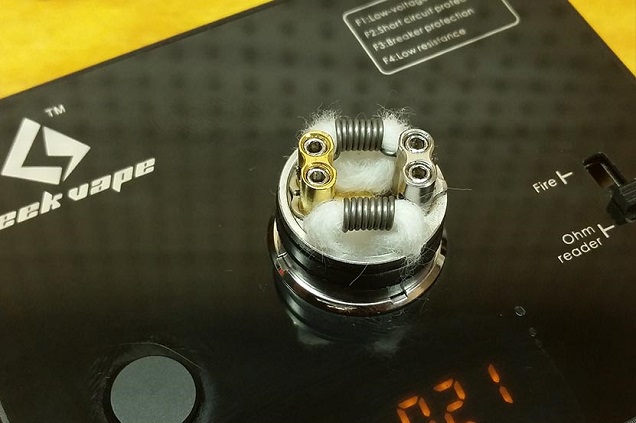
The first challenge for a journalist who knows nothing about vaping but is trying to write about dripping is to describe what it is. Reading these articles, you immediately know that the authors really don’t understand what they’re talking about. The descriptions have a Chinese whispers-like feel to them, like the truth was once there but successive people’s ignorance of what that is has led to it being buried too deeply to be unearthed. Here’s a selection of the attempts:
…a potentially dangerous new vaping method called “dripping” – dropping e-cigarette liquid directly onto the hot coils of the device to produce thicker, more flavourful smoke.
‘Dripping’ […] differs from normal e-cigarette use that slowly releases the liquid from a wick onto a hot atomizer (South China Morning News)
Teens are dropping e-cigarette liquid onto the hot coils of the device to produce more smoke and flavor (NBC2)
With dripping, it's more hands on. The user has to manually drop the liquid onto the coil which creates a cloud of vapor they immediately inhale. (3TV)
The implication from these is that dripping involves heating up your coil, dropping e-liquid directly onto the glowing hot metal and then huffing the fumes from above it. The seeds of this were sown by the study’s authors themselves, who write:
‘dripping,’ which involves vaporizing the e-liquid at high temperatures by dripping a couple of drops of e-liquid directly onto an atomizer’s coil and then immediately inhaling the vapor that is produced.
As vapers know, the reality is that dripping is about applying liquid to the wick, not the coil. The wick is soaked with liquid from a tank or clearomizer, too, but when you drip, you manually top up the wick when it’s getting dry. There are tons of vaping sites (including this one) that explain this in detail.
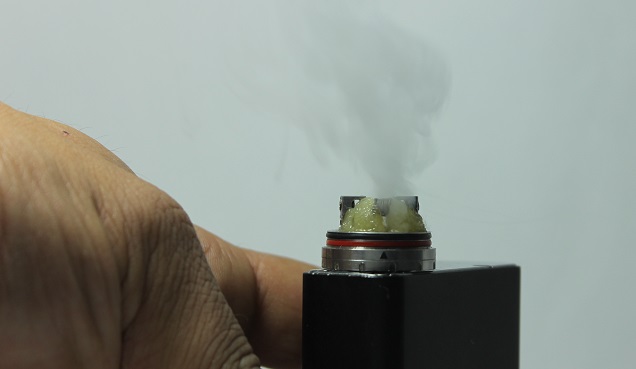
So why did none of these sources do their own research and try to work out exactly what dripping really is? Because the way it’s phrased by the study's authors is absolutely perfect. The practice can’t seem like a natural extension of how e-cigarettes work, it has to be alien and oh-so-dangerous. Why talk about manually soaking room temperature cotton in e-juice before vaping when you could evoke images or teens tossing poisonous liquid onto glowing hot coils and then vacuuming up the resulting fumes like desperate crack-heads?
They Treat the Word ‘Dripping' Like It's Street Slang for Drug Abuse
The word “dripping” takes on special significance in the news reports. Like “crunking,” “tripping” and “tweaking,” it’s a seemingly innocuous word that has a special “street” significance related to using a substance. It has a perfect quality for media scare-stories, because it makes you think “my kid might have said he was ‘dripping’ and I thought nothing of it!” This type of reporting makes you feel like the truth has been in plain sight all along, and puts parents on high alert for weird terms like “meow meow” or “spice.”
Most of the articles refrained from explicitly rattling off slang terms in the manner of an expose on a new designer drug, but a worker for an Arizona rehab center called Stephanie Siete couldn’t resist: “Vaping, e-cigs, dripping, juiling, modding — they are all similar.”
Don’t ask me what “juiling” is (Googling it just made me more confused).
The truth is that “dripping” really is slang, but not a surreptitious way for teens to talk about “vape abuse” on the playground. It’s from the early days of vaping, banded around in online forums primarily inhabited by adult smokers looking for a safer way to enjoy nicotine. Shocking stuff, I know.
They Distort Teens' Motivations – Getting a “Stronger Hit”
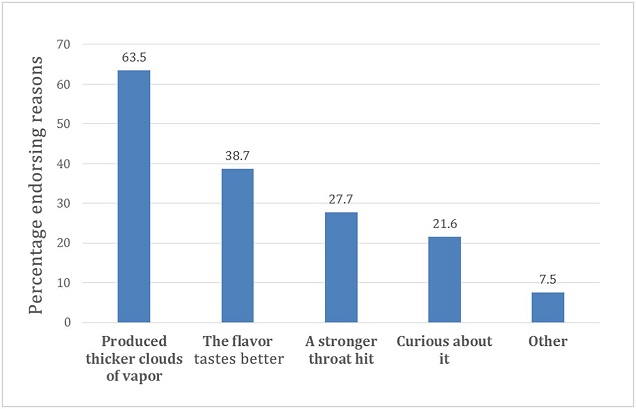
The researchers of the study asked the teens who dripped why they did it, and the options for responses were:
- “I do not use dripping,” (yes, they really said “use” dripping)
- “It makes the flavor taste better”
- “It makes a stronger throat hit”
- “It makes a thicker cloud of vapor”
- “I was curious”
- “Other”
More vapor and better flavor were the two most common answers (aside from people who don’t “use” dripping), with throat hit being the third most common. How did the Sun deal with this fact? By calling dripping a “craze that gives teens stronger hit.”
“Throat hit” might be a bit tough to explain in a tabloid-length article aimed at the general public, but calling it a “stronger hit” has clear connotations and the only purpose of making this claim so prominently was to strengthen the association with drug use. It’s the way you’d describe somebody who decided to switch from cocaine to crack, not a teen who wants bigger clouds and better flavors.
They Describe the Nicotine Dose as “Intense”
After setting the scene with innuendo and laughable descriptions of the “dangerous” new fad, the media went for the jugular. The best example comes from Arizona’s 3TV, where Ashley DeMartino said dripping “gives a faster, more intense and higher dose of nicotine to the user.”
Not content with that, the article quotes Dr. Frank LoVecchio, who bafflingly states:
So, imagine that if you took all of that in; you're sucking in almost one cigarette at one time.
This is patently absurd. The idea that dripping gets you more nicotine seems to be true (at least from anecdotal experience), but the authors themselves point out: “many of the online guides on dripping discuss the use of appropriate nicotine levels,” referencing a Spinfuel article. Unsurprisingly, this article recommends using much lower nicotine levels for dripping – as low as 3 mg/ml.
The reason for this is that dripping an 18 mg/ml e-juice is unpleasant. You get too much nicotine, which – contrary to the drug parallels the media tries to draw – doesn’t feel nice. The main sign you’ve had too much is nausea, not some drug-like euphoria. To get the same amount of nicotine from dripping (or using sub-ohm tanks) as you get from ordinary vaping, you need to reduce your nicotine level by a factor of three or more.
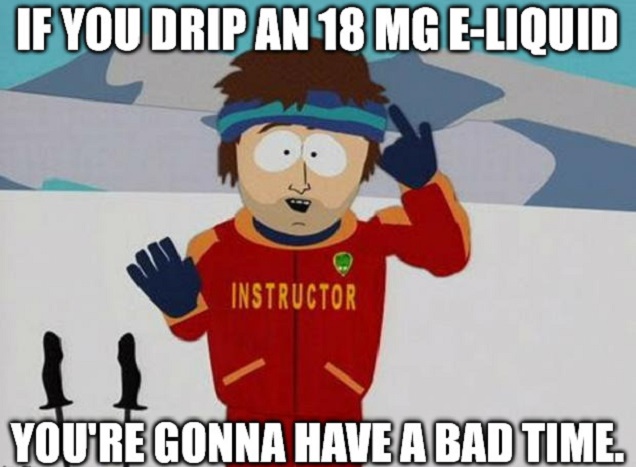
Dripping isn’t intended to get vape-fiends a bigger hit of nicotine; it’s about increasing your vapor production and flavor while getting about the same amount of nicotine. But, if you’re painting dripping as a dangerous new drug-like trend, vastly exaggerating the dose is a key step.
They Talk About How “Dangerous” Nicotine Is (But Not Whether Teens Who Drip Use It)
What’s the point of exaggerating doses if you aren’t going to talk about how dangerous it is? Dr. LoVecchio is there to offer the quote they want:
It can cause seizures; it can cause you to go comatose; it can cause your heart rate to rise quickly.
And he continues:
The more nicotine you get, the more likely you are to be addicted. The more addicted you are, the more you want to consume it and the more your body is going to want it.
The picture of the vape-fiend painted by these stories is really taking shape now. After all of the framing, the innuendo and the clueless claims, they all move onto a kicker just like this. The “new” dripping trend is probably a plot from the evil e-cigarette companies to make more kids addicted, you’re supposed to think.
But then if you read the study – which is free – you may notice something. The authors point out that, “We also did not assess whether nicotine was present in the e-liquids used for dripping.” To their credit, some news outlets pointed this out, but the vast majority didn’t.
Even if dripping really did expose you to more nicotine – which the researchers didn’t establish and which vapers specifically recommend reducing your nicotine level to avoid – it’s basically unthinkable that it’d be enough to give you a seizure or send you into a coma. That’s serious overdose territory, not the faint nausea you feel when you’ve had a few too many puffs or chain-smoked a couple of cigarettes.
The fact that they didn’t even establish that nicotine was involved at all makes the whole thing absurd, especially with existing data suggesting only about 1 in 5 teens who vape use nicotine.
They Name Some Scary-Sounding Chemicals and Exploit Dry Puff Scenarios
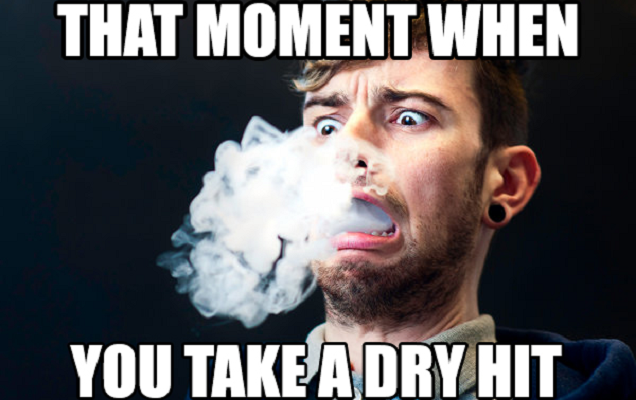
The ace-in-the-hole for these articles tends to involve the familiar lists of scary-sounding chemicals detected in e-cigarette vapor.
The Sun went with:
Evidence shows “dripping” raises the risk of exposure to chemicals including formaldehyde, acetaldehyde and acrolein, in the vapours.
CNN quotes the study’s lead author:
“Higher temperatures lead to greater emissions of a class of harmful chemicals known as volatile aldehydes,” including formaldehyde and acrolein, Shihadeh said.
In the paper, Shihadeh and colleagues cite another study he worked on which tested the emissions from “direct dripping.” He explains the main result to CNN as, “the aldehyde emissions were much greater than what we measured using conventional e-cigs.”
So if you believe the media, this “dangerous new trend” has drug-like street slang, involves dripping poison directly onto glowing hot coils powered by a probably-ready-to-explode battery and then inhaling the aldehyde-laden, high-nicotine fumes that come out of the top.
Does Dripping Expose You to Dangerous Levels of Aldehydes?
Most of that is clearly a little silly. But what about Shihadeh’s claim that aldehyde emissions from dripping atomizers are higher than the emissions for cigarettes? Well, that really is what they found. As with the New England Journal of Medicine study (and most of those on formaldehyde in e-cigarettes), though, the methodology is likely to blame for the results.
In the poorly-explained methods section of the full paper, the authors write: “Puff duration was set at 8 seconds, with a puff velocity of 19.1mL/s and an interpuff interval of 10 seconds.”
They used eight second puffs in the test, despite evidence directly looking at vapers’ habits showing that four seconds is a much more realistic figure. Couple this with a short gap between puffs (just 10 seconds) and the fact that they did 2 to 4 puffs before topping up (either with one or two drops, depending on whether you believe the abstract or the full paper), and you can see why dry puffs and aldehydes might be a factor.
If you’re wondering if they used a high-quality, modern RDA: of course they didn’t! They went with the NHALER 510 dripping atomizer, which is like an early dripper built into something that looks like a cartomizer or clearomizer. The study was published in 2016, but apparently the authors didn’t consider picking up some more relevant, modern gear to use.
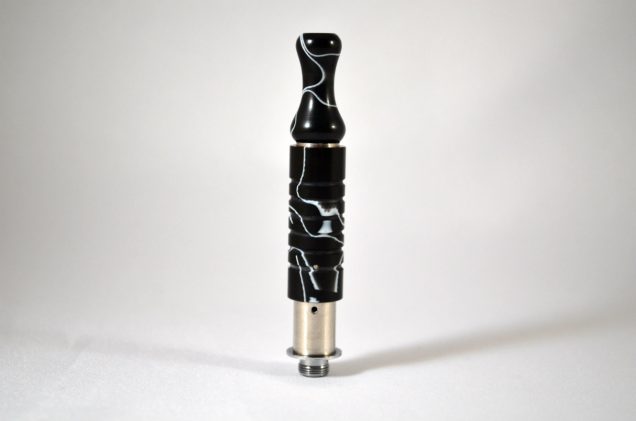
The results of the study show that under the two puffs per drip/two drips (again, not sure which) protocol, there was 19.7 μg of formaldehyde for every 15 puffs, compared to 21.5 μg for the cigarette tested. At three puffs per drip (or two), formaldehyde levels rose to 71.3 μg/15 puffs, and at four puffs per drip (or two) it went up to 88 μg/15 puffs. For acetaldehyde, the situation is pretty similar.
If you’re interested in more info on what we know about aldehydes and vaping, we have a pretty detailed post on the topic here. However, the short version is that “dry puff” scenarios lead to concerning levels of aldehydes, whereas under realistic vaping conditions, levels are much lower than from cigarettes.
This graph from the study lends strong support to the idea that the method created dry puffs.

Formaldehyde levels increase dramatically at the third 8-second puff. As it happens, that’s just the same time as there is a huge spike in temperature. By the fourth puff, the temperature is far above the maximum setting allowed by any temperature control mod. The reason is simple: this is a horrible methodology that in no way represents how vapers vape in the real world. With little liquid in the wick, temperatures rise, PG thermally degrades to formaldehyde and your vapor starts to taste unbearably nasty.
But as we know, this never stops researchers making bizarrely-confident statements about how realistic their methodologies are and it never stops the media from treating the results as if they apply to every single vaper.
None of this means that we shouldn't look for reliable evidence on the potential risks of dripping, though. Compared to closed systems or even basic tanks, dripping does increase vapor production, and generally means you get through more e-liquid each day. And even though you probably won't reach dry-puff-like temperatures, there probably will be some differences between using a clearomizer and an RDA when it comes to temperature and the levels of potentially harmful chemicals. However, if we are to find out about those differences, we need well-designed research and objective reporting of the results. Extrapolating based on a single poorly-performed study is a recipe for disaster.
Have a Quarter of Teens Who’ve Vaped Really Tried Dripping?
You might be wondering why RDAs – something you need a bunch of extra tools and supplies to even get working – are quite so popular among the 16-year-old students in the recent survey. Have a quarter of the high school students who’ve tried vaping really used one of them?
As Amelia points out in the comments, the survey’s question about dripping probably led to a serious over-estimation of how much dripping is really going on.
The question they asked is unclear, to say the least:
Have you ever used the dripping method to add e-liquid to your e-cigarette?
The meaning of “dripping method” doesn’t seem to have been explained, and it’s really what you’re dripping it onto or into that makes the difference. Combined with their definition of e-cigarettes, which specifically mentioned that some can be refilled, this could have easily led some of the students into thinking they were asking about refilling tanks. It also seems to have confused about a quarter of them so much they responded “I don’t know.”
The upshot is that many (if not most) of the 26 % probably misinterpreted the incoherent question and answered “yes” despite having never used dripping atomizer, making the concern about the results even more overblown.
(Thanks again to Amelia, who you should definitely follow on Twitter.)
Media Fearmongering at it’s Best: Panic Without Context
The dripping scare is the perfect storm of vaping misinformation. It includes a scary-sounding new trend, teenagers inhaling “intense” doses of nicotine and more aldehydes than you can shake a stick at. It’s no surprise the media ate it up. They drew from their decades of experience making parents terrified of the new menace on the playground and did everything they could to make vaping teens sound like meth-heads waiting to happen.
And for all of this, it shouldn’t surprise you that the vastly safer nature of vaping compared to smoking – whether you drip or not – was barely mentioned in these write-ups, if at all. And it also shouldn’t surprise you that nobody mentioned the fact that 82 % of the teens who’d ever vaped in the study had also tried other tobacco products, such as cigarettes. Nor should it surprise you that they didn’t mention that the people who’d “tried dripping” also smoked over three times more cigarettes per day than those who didn’t.
Because putting results like this into context makes it a lot harder to generate outrage. If people read that, they might get the idea e-cigarettes are a great way to reduce the harm from nicotine use, whether you’re a teen or an adult.

